Policy framework for reducing homelessness and service response
Governments across Australia fund a range of services to support people who are homeless or at risk of homelessness. These services are delivered by non-government organisations including agencies specialising in delivering services to specific target groups (such as young people or people experiencing domestic violence), as well as those that provide more generic services to those facing housing crises.
This report describes:
- The people who received assistance from specialist homelessness agencies in 2016‒17, the assistance they received and changes in their housing and other circumstances.
- Trends in the characteristics of clients, the services they received, and their outcomes.
- The people who requested services in 2016‒17 but were not able to be provided with support at that time.
For the first time in 2016–17, data describing clients with problematic drug and/ or alcohol use are presented in a single snapshot. Data describing clients living with disability are presented from 2013–14 onwards.
The data in this publication are compiled from the Specialist Homelessness Services Collection (SHSC), which is conducted by the Australian Institute of Health and Welfare (AIHW). Data are provided to the AIHW by around 1,500 homelessness agencies allowing this report to be compiled and published. The AIHW thanks them and their clients for making this possible.
People who are homeless or facing homelessness may also access a range of mainstream services that are available to the broader community (such as income support payments or health services). These services are not described in this report.
Policy framework for reducing homelessness
Many Australians experience events in their life that may place them at risk of homelessness. It is estimated that just over half (51%) of lower income households experience housing affordability issues due to rental stress (paying more than 30% of their gross income on housing costs) (ABS 2017a), and around 1 in 6 women (1.6 million) have experienced some form of domestic and family violence in their lifetime, putting them at risk of homelessness (ABS 2017b).
On Census night in 2016, 116,427 Australians were homeless. This marked a 4.6 per cent increase in the rate of homeless persons over 5 years, from 47.6 per 10,000 in 2011 to 49.8 in 2016. Census homeless estimates include people in supported accommodation for the homeless, people in temporary accommodation, those ‘sleeping rough’ and people living in severely crowded dwellings (those that required 4 or more extra bedrooms to accommodate the residents) (ABS 2018).
The Federal Government announced the establishment of a new National Housing and Homelessness Agreement (NHHA) in the 2017–18 Budget, reforming the previous funding agreements with states and territories (the National Affordable Housing Agreement (NAHA) supported by the National Partnership Agreement on Homelessness (NPAH)). The proposed $4.6 billion NHHA includes $375.3 million over three years to fund front-line homelessness services, and comes into effect 1 July 2018. The Government has also provided $117.2 million via a Transitional National Partnership Agreement on Homelessness for 2017–18 to provide services with certainty while governments work together to finalise the new agreement (Australian Government 2017).
About the Specialist Homelessness Services Collection
The SHSC began on 1 July 2011. The collection has been designed to collect data from homelessness agencies that are funded under the NAHA and the Transitional NPAH. State and territory departments identify agencies that are expected to participate in the data collection. These agencies vary widely in terms of the services they provide and the service delivery frameworks they use. These frameworks may be determined by the state or territory funding department or developed as a response to local homelessness issues (see What are specialist homelessness agencies for more details).
All SHSC agencies report standardised data about the clients they support each month to the AIHW, as specified in the Specialist Homelessness Services National Minimum Dataset (NMDS). Data are collected about the characteristics and circumstances of clients when they first present at an agency. Further data―on assistance received and circumstances―are collected at the end of every month in which the client receives services and again when contact with the client has ceased. Some data are self-reported, others require consent to publish. Information regarding these items is found in Technical information.
This information contributes to building a picture of clients, the specialist homelessness services that were provided to them and outcomes achieved for those clients (Figure FRAMEWORK.1). SHSC data provide a measure of the service response directed to those who are experiencing housing difficulty. The data do not provide a measure of the extent of homelessness in the community, although SHSC data on emergency and supported accommodation do contribute to the profile of homelessness in Australia.
Figure FRAMEWORK.1: Conceptual framework of the SHSC client collection
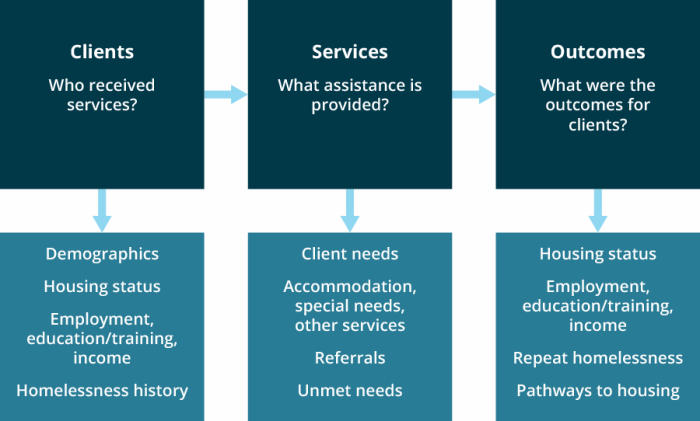
The data collected by agencies are based on periods of support provided to clients. These support periods vary in terms of their duration, the number of contacts between Specialist Homelessness Services (SHS) workers and clients, and the reasons support ends. Some support periods are relatively short (and are likely to have begun and ended in 2016–17) and others are much longer―many of these might have been ongoing from the previous year, and/or were still ongoing at the end of 2016–17.
Certain information collected about the client (selected letters of name, date of birth and sex) is used to construct a statistical linkage key (SLK). This SLK brings together all data about each client who had multiple support periods (either with the same agency or with different agencies) during the reporting year. Note that while a client may have received SHS support in a previous year, use of homelessness services in prior year(s) is out of scope for SHS annual reporting purposes.
All data presented in this report and in the Supplementary tables have been adjusted for agency non-response and data error in the statistical linkage key (SLK). Detailed information about the weighting and estimation strategy for 2016–17 can be found in Technical information.
Data tables from which these analyses are drawn are provided as supplementary tables to this report. All percentages given are based on valid responses reported for clients, and the extent of missing data is indicated in the supplementary tables.
Further information about the collection, imputation methodology applied to these data, and information about the quality of the data obtained through the SHSC for 2016–17 is available in Technical information.
Delivery of homelessness services across Australia
Each state and territory manages their own system for the assessment, intake, referral and ongoing case management of specialist homelessness services clients. Box FRAMEWORK.1 summarises the delivery systems operating in Australia. Although presented as 3 distinct delivery models, these systems are representative of a range of approaches jurisdictions may employ to coordinate entry into specialist homelessness services. Changes implemented by jurisdictions in the delivery of services and their associated responses have the potential to impact SHSC annual data.
Box FRAMEWORK.1
Community sector funding and support
- Assessment & intake: managed by individual SHS providers, consistent with state or territory policies.
- Referral: refer to other SHS providers if clients’ needs are not able to be met by initial SHS provider.
- May be supported by a coordinating service.
Central information management
- Assessment, intake and referral: managed at any SHS provider, via state or territory central information management tool.
- Central information management system assists in the identification of appropriate services and indicates the availability/vacancy of services at all SHS providers.
Central intake
- Assessment, intake and referral: managed by one or more ‘central intake’ agency.
- Central intake agencies prioritise access to services and only refer clients as services and/or vacancies are available.
- Central information management tool may exist to share information between SHS providers.
What are specialist homelessness agencies?
A specialist homelessness agency reporting to the SHSC is an organisation that receives government funding to deliver accommodation-related and personal services to people who are homeless or at imminent risk of homelessness. While it is recognised that other organisations not directly funded by the government also provide a wide range of services to this sector, these organisations are not required to provide data to the SHSC.
SHS agencies vary considerably in size and in the types of assistance they provide. Across Australia, agencies provide services aimed at prevention and early intervention, crisis and post crisis assistance to support people experiencing or at risk of homelessness. For example, some agencies focus specifically on assisting people experiencing homelessness, while others deliver a broader range of services, including youth intervention services, domestic and family violence services and housing support services to those at risk of becoming homeless. The service types an agency delivers range from basic, short-term interventions such as advice and information, meals, and shower/ laundry facilities through to more specialised, time-intensive services such as financial advice and counselling and professional legal services (see Glossary for a complete list of service types).
Nationally, there were 1,518 agencies that delivered specialist homelessness services to an estimated 288,273 clients during 2016–17 (Figure FRAMEWORK.2).
Figure FRAMEWORK.2: Specialist homelessness agencies and clients, by jurisdiction, 2016–17
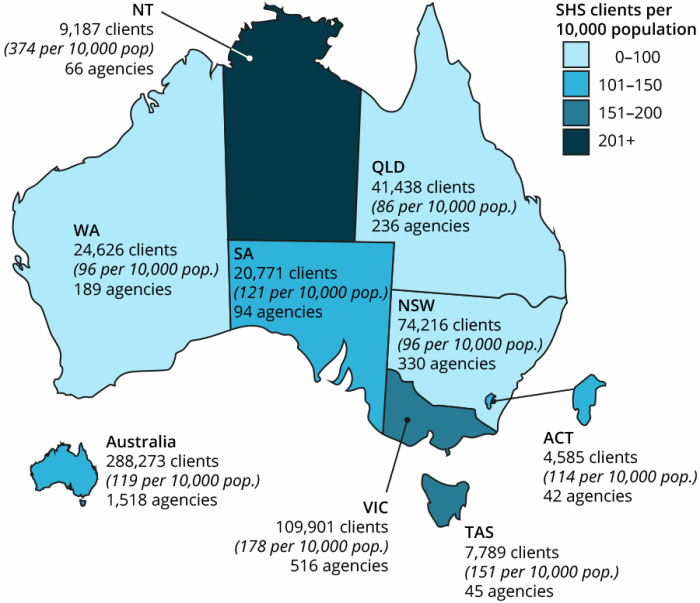
Notes
- Client count has been adjusted for non-response. Clients may access services in more than one state or territory, therefore the Australia total will be less than the sum of jurisdictions.
- The agency count includes only those agencies that provided support periods with valid SLKs.
Source: Specialist homelessness services 2016–17.
Agencies range considerably in size, with some agencies assisting 100 clients per year and others upward of 1,500. Some agencies are represented by a larger ‘parent’ organisation while others are individual stand-alone agencies. The number of clients agencies assist (agency size) not only reflects the type and complexity of services provided, but also differing state and territory service delivery models. Agency size is also influenced by jurisdictional-specific factors such as the size and geographical distribution of their population. Figure FRAMEWORK.3 illustrates the wide range in agency sizes within each jurisdiction. In 2016–17 the largest proportion of agencies assisted fewer than 100 clients in all jurisdictions except New South Wales, ranging from 57% in Western Australia and the Australian Capital Territory to 30% in South Australia. In New South Wales, a slightly higher proportion of agencies assisted between 100–199 clients than fewer than 100 clients (28% compared with 27%, respectively). Agencies assisting a large number of clients (more than 1,500 in 2016–17) exist in all jurisdictions except the Northern Territory. Victoria has the most agencies of this size (22 agencies).
Figure FRAMEWORK.3: Specialist homelessness agencies, by client range and jurisdiction, 2016–17
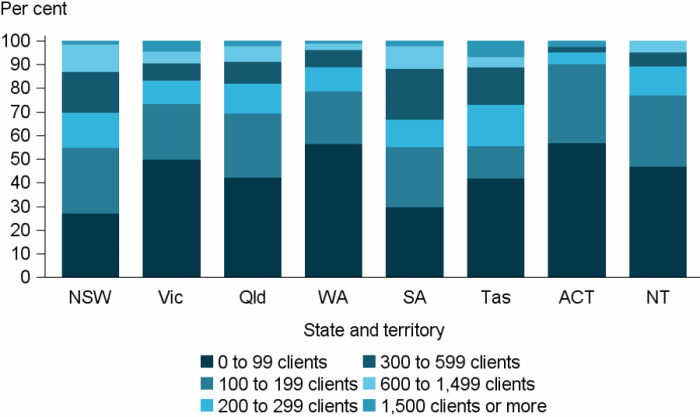
Note: Client count has been adjusted for non-response.
Source: Specialist homelessness services 2016–17.
SHS agencies and their service delivery
Specialist homelessness services can either be provided to the client by the agency, or a client may be referred to another agency for a specific service (Figure FRAMEWORK.4). In some instances, a client may neither receive nor be referred for a service and their need therefore goes unmet. These unmet needs are captured to assist in determining the ability of the sector to respond to client needs.
Sometimes, SHS agencies are unable to assist people who are homeless or at risk of homelessness. These instances are captured to assist in determining the ability of the sector to cope with demand. An ‘unassisted request for service’ is an instance where a person(s) who approaches an agency is unable to be provided with any assistance (see Technical Information).
Figure FRAMEWORK.4: Access to and delivery of Specialist Homelessness Services
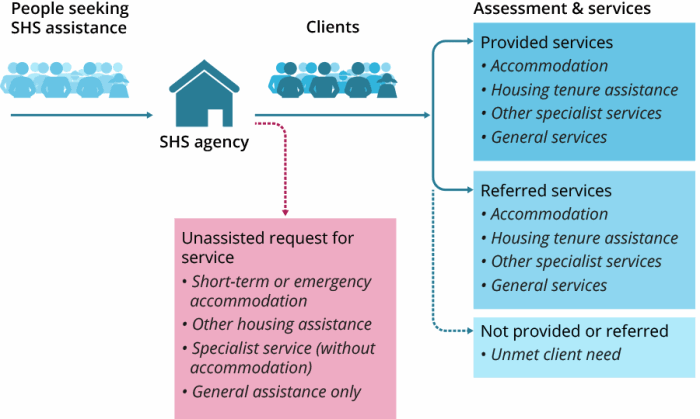
Services provided by specialist homelessness agencies in all jurisdictions can be categorised as either ‘accommodation services’ (either the direct provision of accommodation or assistance for the client to remain housed) or ‘services other than accommodation’ (figure FRAMEWORK.5). The proportion of SHS clients receiving accommodation services varied across states and territories in 2016–17 with over 7 in 10 clients in Tasmania (78%) and Queensland (72%) receiving these services (FRAMEWORK.5). In contrast, 55% of clients in South Australia were provided services other than accommodation. This variation reflects differences in the demand for accommodation services, service delivery models, and housing options across jurisdictions.
Figure Framework.5: Clients of Specialist Homelessness Services, by service type, states and territories, 2016–17
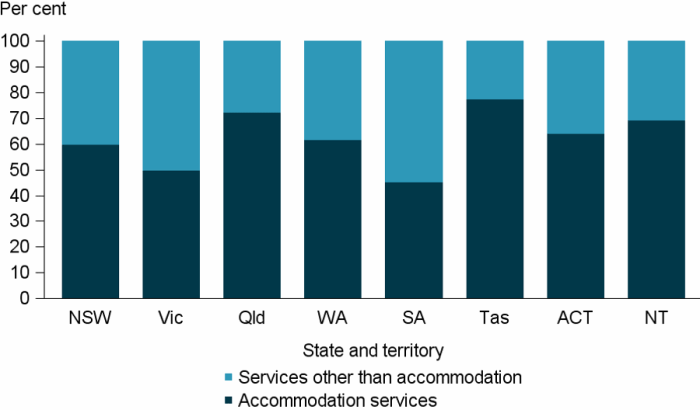
Notes
- Clients provided or referred accommodation services (short-term or emergency accommodation, medium-term/ transitional housing, long-term housing, assistance to sustain tenancy or prevent tenancy failure or eviction and assistance to prevent foreclosures or for mortgage arrears) are included in the accommodation services category. These clients may have also been provided additional services other than accommodation.
- The denominator for the proportions is the number of clients who were provided or referred any service during 2016–17.
- Clients may access services in more than one state or terrritory. If they received accommodaton services in any jurisdiction they will be counted as having received these services in all jurisdictions in which they received services.
- The proportion of clients who received accommodation services broadly reflects the demand for accommodation services in each jurisdiction and may be influenced by the delivery model employed in the state or territory and/or a limitation in accommodation stock of the jurisdiction.
Source: Specialist Homelessness Services, 2016–17.
References
- Australian Bureau of Statistics (ABS) 2017a. Housing and occupancy costs, 2015–16. ABS cat no. 4130.0. Canberra: ABS.
- ABS 2017b. Personal safety, Australia, 2016. ABS cat no. 4906.0. Canberra: ABS.
- ABS 2018. Census of population and housing: estimating homelessness, 2016. ABS cat no. 2049.0. Canberra: ABS.
- Australian Government; Budget 2017. A new national housing and homelessness agreement. Fact sheet 1.7.
http://www.budget.gov.au/2017-18/content/glossies/factsheets/download/FS_17_Housing_Affordability.pdf


